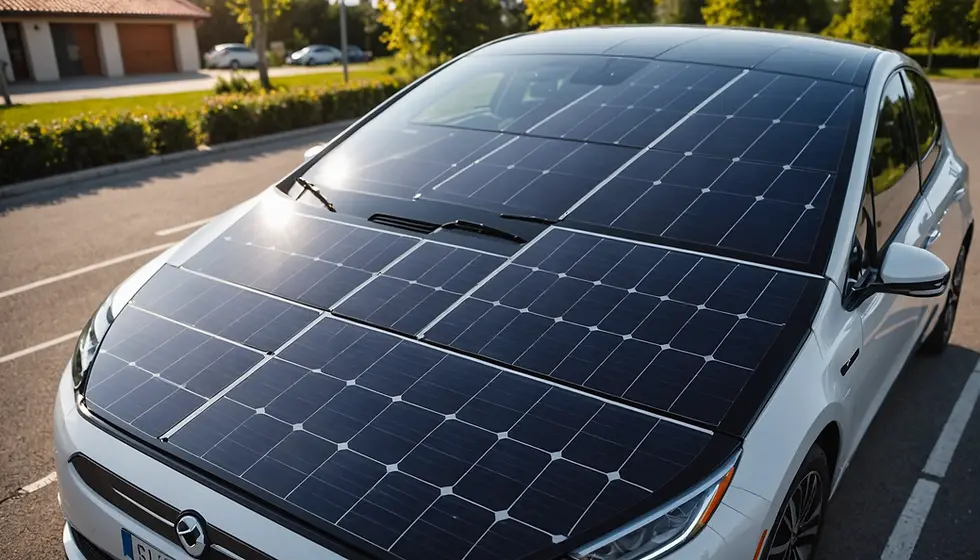extensive list of self-charging technologies available for electric vehicles (EVs)
- Menno Drescher

- Oct 31, 2024
- 3 min read
Here is a comprehensive list of self-charging technologies available for electric vehicles (EVs):
1. **Regenerative Braking**: Converts kinetic energy during braking into electrical energy.
2. **Solar Panels**: Integrates photovoltaic cells into the vehicle to harness solar energy.
3. **Inductive Charging**: Wireless charging using embedded pads in parking spaces or roads.
4. **Wind Energy Harvesting**: Small wind turbines capture energy from airflow.
5. **Kinetic Energy Recovery Systems**: Captures energy from vehicle movement.
6. **Thermoelectric Generators (TEGs)**: Converts waste heat into electricity.
7. **Piezoelectric Energy Harvesting**: Converts mechanical vibrations into electricity.
8. **Electromagnetic Induction**: Generates electricity by moving magnets near coils.
9. **Hydraulic Regenerative Suspension**: Recovers energy from hydraulic fluid in suspension.
10. **Pyroelectric Energy Harvesting**: Converts temperature fluctuations into electricity.
11. **Thermophotovoltaic (TPV) Cells**: Converts thermal radiation into electricity.
12. **Radio Frequency (RF) Energy Harvesting**: Captures energy from ambient radio waves.
13. **Vibration Energy Harvesting from HVAC System**: Converts HVAC vibrations into electricity.
14. **Tire Pressure Monitoring System (TPMS) Energy Harvesting**: Powers sensors using tire vibrations.
15. **Triboelectric Nanogenerators (TENGs)**: Converts mechanical energy from friction into electricity.
16. **Hybrid Solar and Wind Energy Harvesting**: Combines solar panels with wind turbines.
17. **Hybrid Kinetic and Thermal Energy Harvesting**: Combines regenerative braking with TEGs.
18. **Multi-Source Energy Harvesting Systems**: Integrates multiple energy harvesting technologies.
19. **Electrodynamic Tethers**: Generates electricity by interacting with Earth's magnetic field.
20. **Quantum Dot Solar Cells**: Offers potential for higher efficiency and lower cost.
21. **Biomimetic Energy Harvesting**: Inspired by natural processes like photosynthesis.
22. **Nanogenerators**: Tiny devices converting mechanical or thermal energy into electricity.
23. **Predictive Energy Management**: Uses machine learning for energy optimization.
24. **Vehicle-to-Grid (V2G) Integration**: Allows EVs to interact with the power grid.
25. **Wireless Charging**: Enables automatic charging without physical connectors.
26. **Cloud-Based Energy Optimization**: Uses cloud computing for energy usage analysis.
27. **Energy Storage Optimization**: Develops advanced batteries and supercapacitors.
28. **Materials Science**: Researches new materials for improved energy harvesting.
29. **System Integration**: Designs integrated energy systems within the vehicle.
30. **Crystalline Silicon Solar Cells**: Traditional high-efficiency solar cells.
31. **Thin-Film Solar Cells (CIGS, CdTe)**: Lightweight and flexible solar cells.
32. **Perovskite Solar Cells**: Emerging technology with high efficiency potential.
33. **Tandem Solar Cells**: Combines layers for higher efficiency.
34. **Dye-Sensitized Solar Cells (DSSC)**: Low-cost and versatile solar cells.
35. **Organic Solar Cells (OSC)**: Flexible and lightweight solar cells.
36. **Transparent Solar Cells**: Integrated into windows without obstructing vision.
37. **Solar Concentrators**: Focus sunlight onto smaller, high-efficiency cells.
38. **Solar Tracking Systems**: Adjusts solar panel angle for optimal energy capture.
39. **In-Wheel Motor Regeneration**: Recovers energy directly from wheel motors.
40. **Suspension Energy Harvesting**: Captures energy from suspension movement.
41. **Bi-directional Charging**: Allows EVs to supply power back to the grid.
42. **Advanced Photovoltaic Cells**: Increases energy conversion efficiency.
43. **Lightweight and Flexible Solar Panels**: For easy vehicle integration.
44. **Smart Charging Systems**: Optimizes charging based on solar availability.
45. **Advanced Battery Management Systems**: Monitors and optimizes battery performance.
46. **Onboard Charging Systems**: Converts solar energy for battery use.
47. **External Charging Compatibility**: Compatible with external charging stations.
48. **Solar Panel Area Optimization**: Maximizes energy generation from vehicle surface.
49. **Solar Cell Placement Optimization**: Ensures maximum sun exposure.
50. **Movable Solar Panel Arrays**: Tracks the sun for optimal energy capture.
These technologies enhance the efficiency and sustainability of electric vehicles by utilizing various energy sources during operation.









Comments